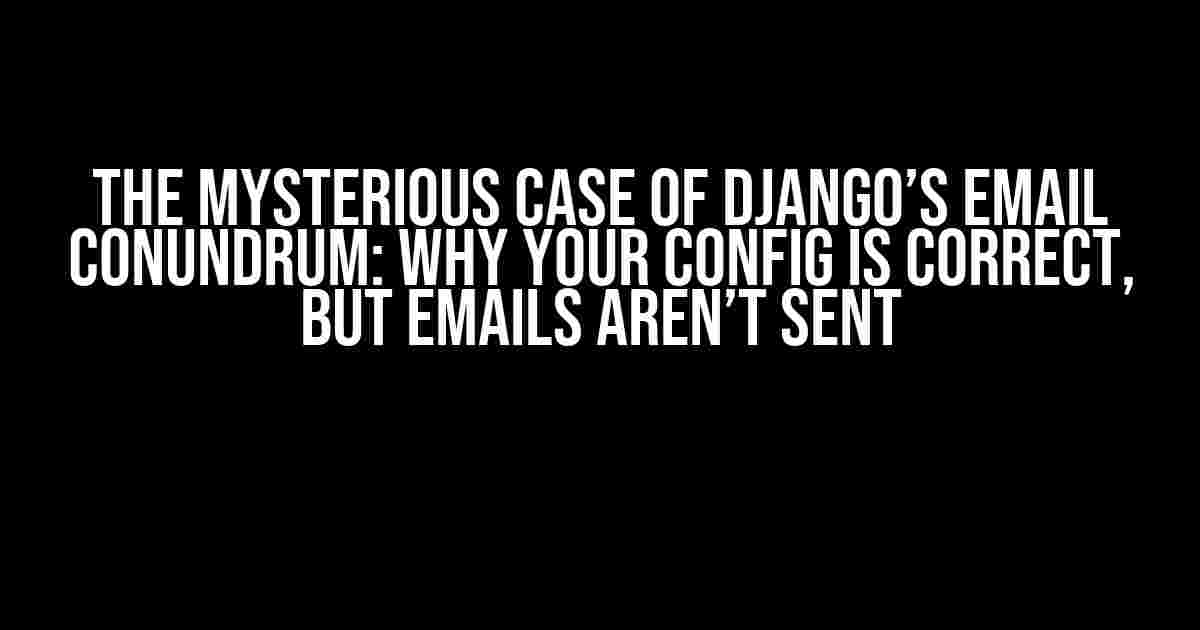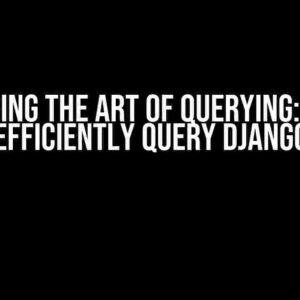Have you ever found yourself in a situation where you’ve meticulously set up your Django project’s email configuration, only to find that emails refuse to budge from your server? You’re not alone! In this article, we’ll delve into the common pitfalls and misconceptions that might be preventing your Django application from sending emails, even though your config seems spot on.
The Initial Investigation
Before we dive into the nitty-gritty of troubleshooting, let’s take a step back and ensure we’re on the same page. Double-check that you’ve set up your email configuration correctly in your `settings.py` file:
EMAIL_HOST = 'your_smtp_server'
EMAIL_PORT = 587
EMAIL_USE_TLS = True
EMAIL_HOST_USER = 'your_email_username'
EMAIL_HOST_PASSWORD = 'your_email_password'
Make sure you’ve replaced the placeholders with your actual email provider’s settings.
Fallback Strategies: Understanding EMAIL_BACKEND
In Django, the `EMAIL_BACKEND` setting determines how emails are sent. By default, it’s set to `django.core.mail.backends.smtp.EmailBackend`. However, if you’re using a third-party email service like Sendgrid or Mailgun, you might need to use a different backend.
Take a closer look at your `settings.py` file and verify that you’re using the correct email backend for your provider:
EMAIL_BACKEND = 'django.core.mail.backends.smtp.EmailBackend' # Default SMTP backend
# or
EMAIL_BACKEND = 'django_sendgrid_backend.backends.SendgridBackend' # Sendgrid backend
If you’re using a custom backend, ensure it’s properly installed and configured.
Email Debugging: A Debugger’s Best Friend
To better understand what’s going on behind the scenes, let’s enable email debugging. Add the following code to your `settings.py` file:
EMAIL_DEBUG = True
The Usual Suspects: Common Email Configuration Mistakes
Now that we’ve covered the basics, let’s tackle some common mistakes that might be preventing your emails from being sent:
- Incorrect SMTP Server Settings: Double-check that your SMTP server settings are correct, including the host, port, username, and password.
- TLS vs. SSL: Ensure you’re using the correct encryption protocol (TLS or SSL) for your email provider.
- Username/Password Issues: Verify that your email username and password are correct and that they’re not being overwritten by environment variables.
- Email Address Formatting: Make sure you’re using the correct email address format (e.g., `[email protected]` instead of `example`).
The Email Sending Process: A Step-by-Step Guide
Let’s break down the email sending process in Django to better understand where things might be going wrong:
- Message Creation: Your Django application creates an email message using the `EmailMessage` class.
- Backend Selection: Django selects the email backend specified in your `settings.py` file.
- Connection Establishment: The chosen backend establishes a connection with the SMTP server.
- Authentication: The backend authenticates with the SMTP server using your username and password.
- Message Sending: The backend sends the email message to the SMTP server.
- Delivery: The SMTP server delivers the email to the recipient’s mail server.
Troubleshooting Email Issues with Django’s Built-in Tools
Django provides a few built-in tools to help you troubleshoot email issues:
1. Email Console
In your Django project’s root directory, run the following command:
python manage.py shell
This will open a Python shell where you can use the `django.core.mail` module to test your email configuration:
from django.core.mail import send_mail
send_mail('Test Email', 'This is a test email', '[email protected]', ['[email protected]'])
If you encounter any errors or issues, this will help you identify the problem.
2. Email Logging
In your `settings.py` file, add the following code to enable email logging:
LOGGING = {
'version': 1,
'formatters': {
'verbose': {
'format': '%(levelname)s %(asctime)s %(module)s %(process)d %(thread)d %(message)s'
},
'simple': {
'format': '%(levelname)s %(message)s'
},
},
'handlers': {
'console': {
'level': 'DEBUG',
'class': 'logging.StreamHandler',
'formatter': 'simple'
},
},
'loggers': {
'django': {
'handlers': ['console'],
'level': 'DEBUG',
},
'django.request': {
'handlers': ['console'],
'level': 'DEBUG',
},
'django.db.backends': {
'handlers': ['console'],
'level': 'DEBUG',
},
'email': {
'handlers': ['console'],
'level': 'DEBUG',
}
}
}
This will log email-related information to the console, helping you debug any issues.
Conclusion
In this article, we’ve explored the common pitfalls and misconceptions that might be preventing your Django application from sending emails, even though your config seems correct. By understanding the email sending process, troubleshooting with Django’s built-in tools, and double-checking your email configuration, you should be able to identify and resolve the issue.
Remember, when in doubt, always check your email configuration, and don’t be afraid to dig deeper into the email sending process. With patience and persistence, you’ll be sending emails like a pro in no time!
| Common Email Configuration Issues | Solutions |
|---|---|
| Incorrect SMTP Server Settings | Double-check SMTP server host, port, username, and password. |
| TLS vs. SSL Issues | Verify the correct encryption protocol (TLS or SSL) for your email provider. |
| Username/Password Issues | Check that your email username and password are correct and not overridden by environment variables. |
| Email Address Formatting | Ensure correct email address format (e.g., `[email protected]` instead of `example`). |
Frequently Asked Question
Get the inside scoop on Django email troubles!
Why Django is unable to send email even though the configuration is correct?
One possible reason is that the email settings in your Django project’s settings.py file are being overridden by another part of your code. Double-check that you haven’t accidentally set the EMAIL_HOST, EMAIL_PORT, or other email settings elsewhere in your code. Also, ensure that the email backend is properly configured and that the email host and port are correct.
Could it be related to permissions or access rights?
Absolutely! Django might not have the necessary permissions to access the email server or send emails. Make sure that the Django process has the required permissions and access rights to the email server. You can try setting the EMAIL_USE_TLS or EMAIL_USE_SSL to True, depending on your email server’s requirements. Additionally, verify that the email server credentials are correct and that the email server is configured to allow Django to send emails.
Are there any specific email settings that I should review?
Yes, there are a few crucial email settings to review. Check that EMAIL_HOST, EMAIL_PORT, EMAIL_USE_TLS, and EMAIL_USE_SSL are correctly set. Also, verify that the EMAIL_HOST_USER and EMAIL_HOST_PASSWORD are correctly configured. If you’re using a Gmail SMTP server, you might need to allow less secure apps or generate an App Password for your Django project.
Could it be a problem with my email template or content?
It’s possible! Issues with the email template or content can prevent emails from being sent. Verify that your email template is correctly configured and that the email content is well-formed. Check for any syntax errors or incorrect template variables. Also, ensure that the email subject and body are properly encoded and don’t contain any invalid characters.
How can I troubleshoot email sending issues in Django?
To troubleshoot email sending issues, you can use the email backend console to inspect the email sending process. Set EMAIL_BACKEND to ‘django.core.mail.backends.console.EmailBackend’ to see the email content and headers in the console. You can also use a package like django-debug-toolbar to inspect the email sending process. Additionally, check the Django logs for any error messages related to email sending.


